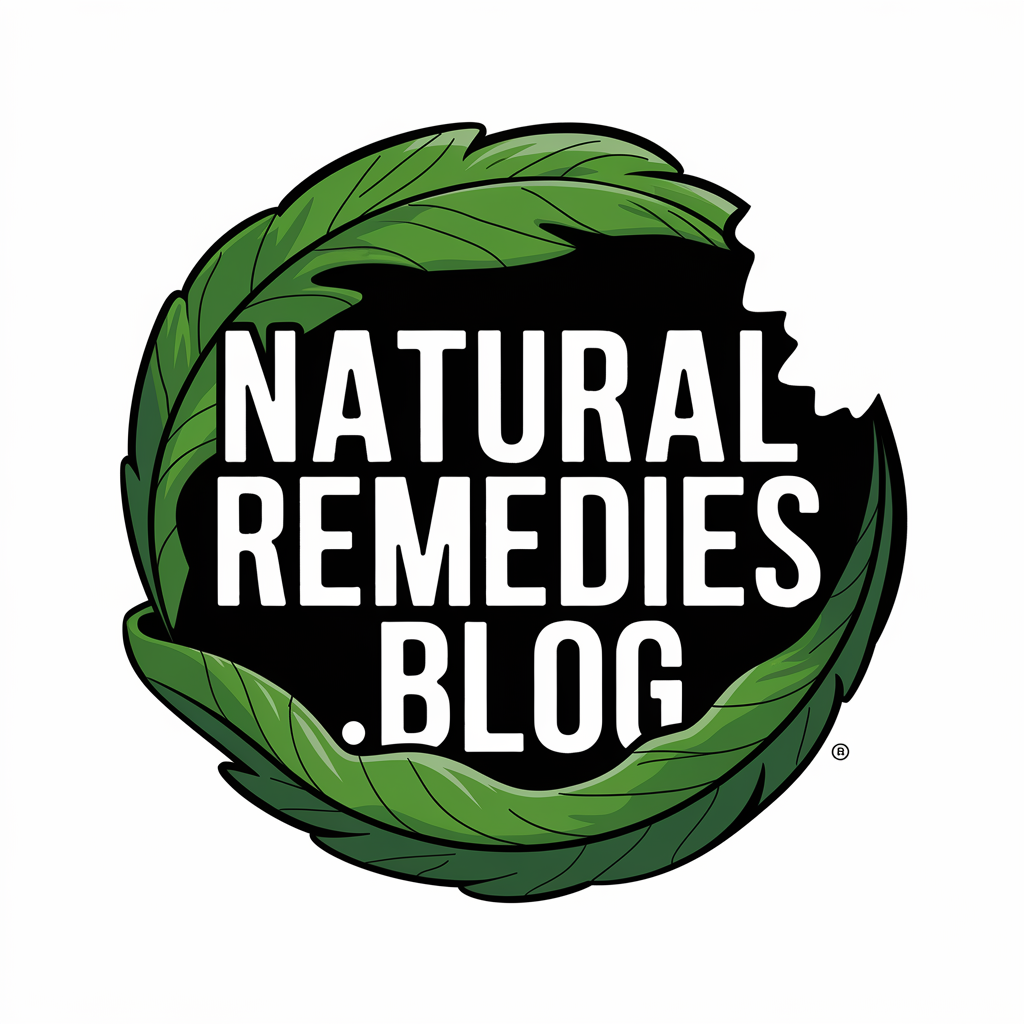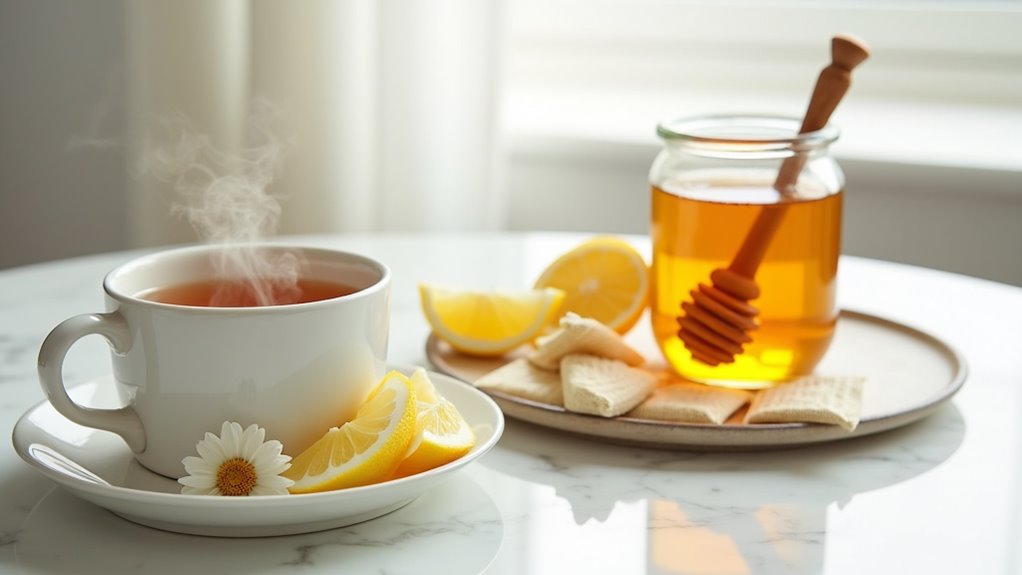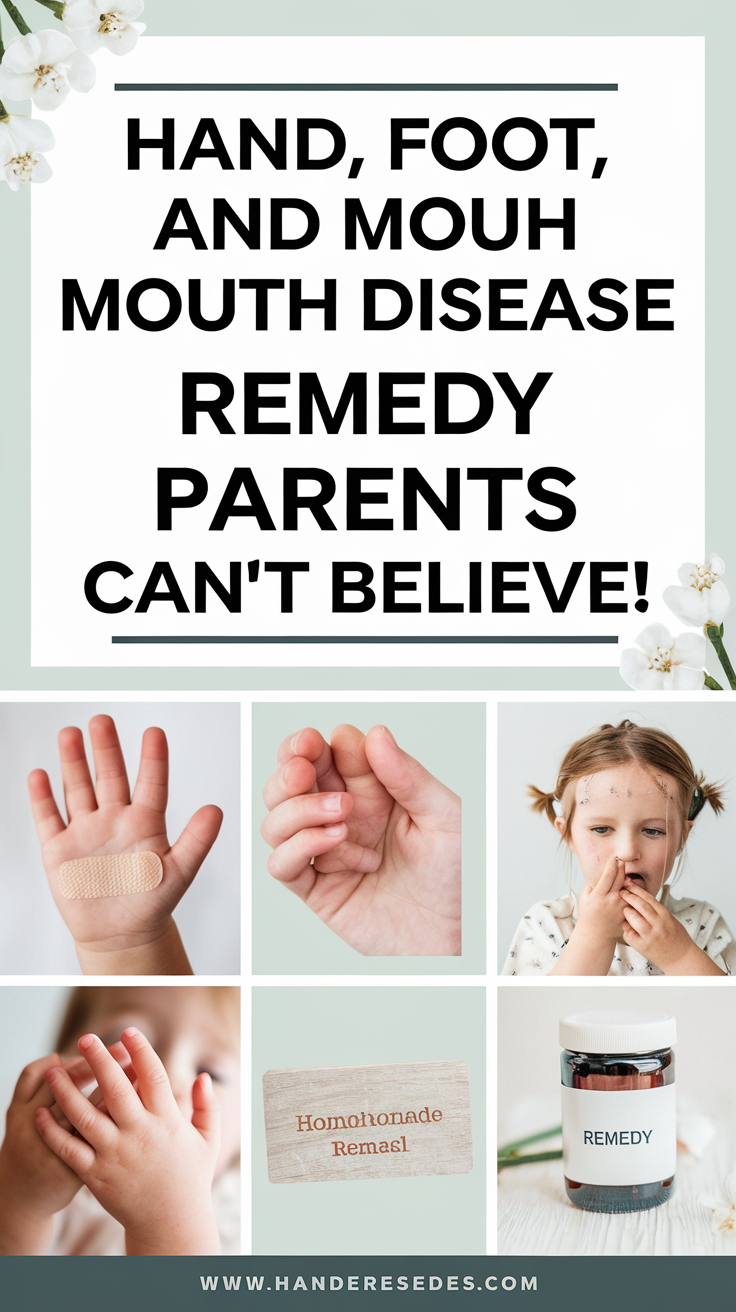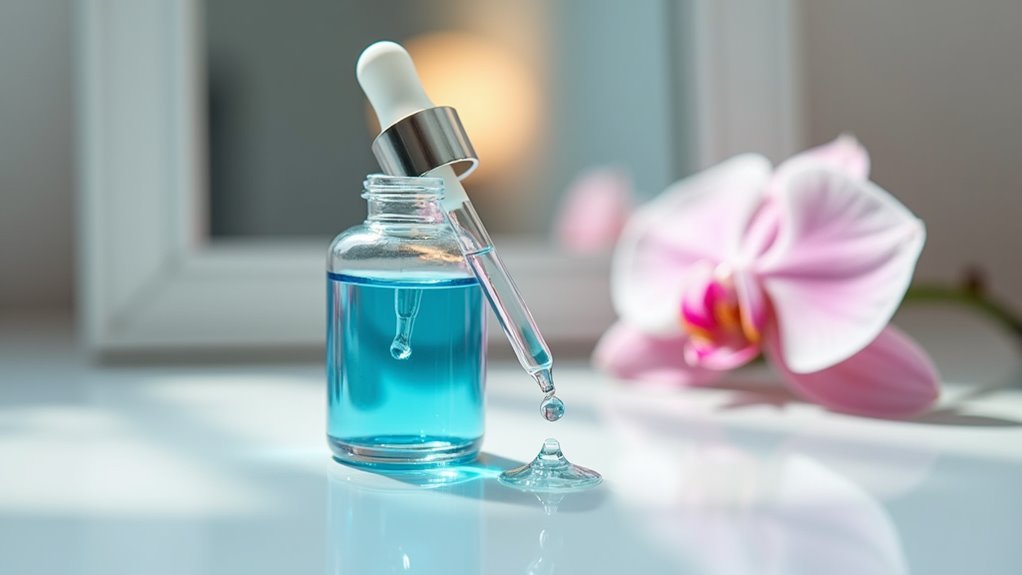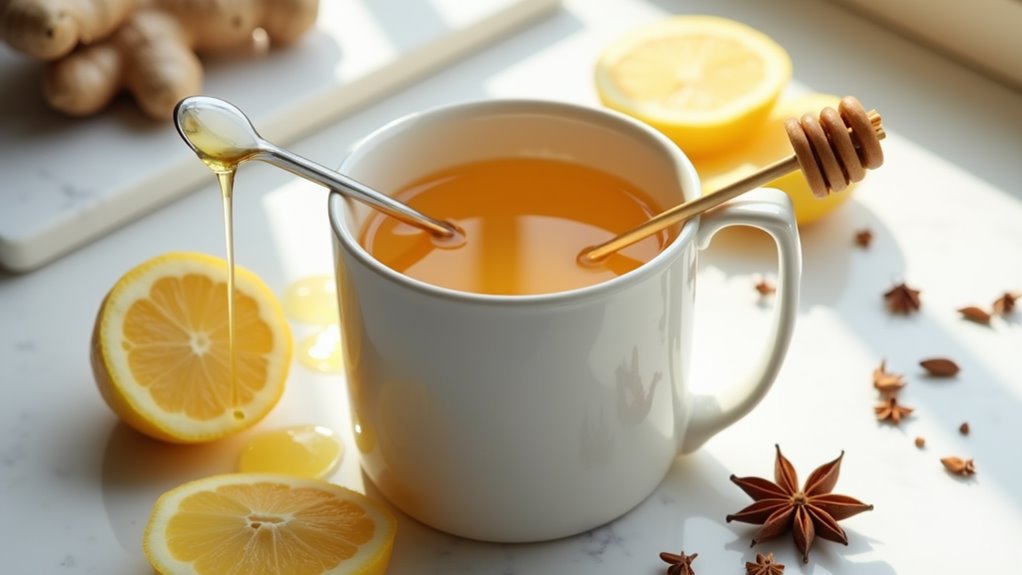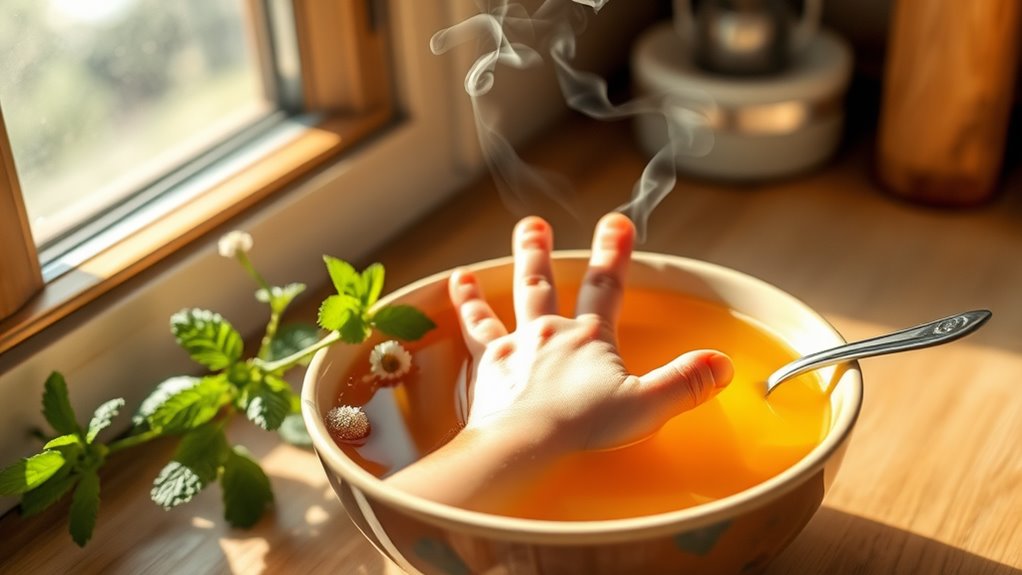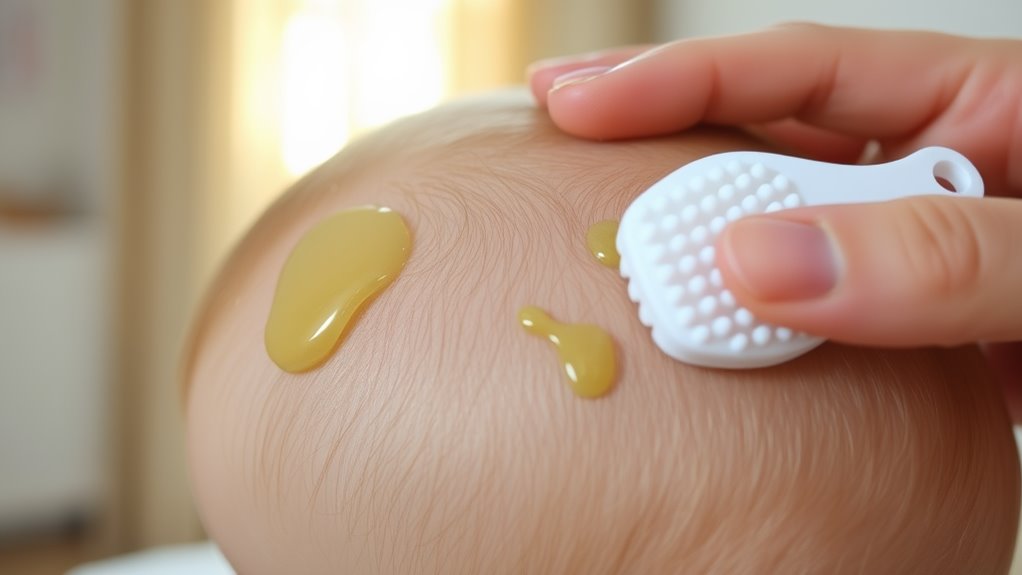Hand, Foot, and Mouth Disease Remedy Parents Can’t Believe!
You’ll be amazed at how coconut oil can effectively treat your child’s Hand, Foot, and Mouth Disease symptoms. This natural remedy’s antiviral properties help combat the virus while soothing painful sores and blisters on hands, feet, and mouth. Simply apply organic coconut oil directly to affected areas several times daily, and combine it with essential oils like tea tree or lavender for enhanced healing. Discover why parents are calling this gentle solution their secret weapon against HFMD.
Key Takeaways
-
Coconut oil’s natural antiviral properties effectively soothe painful sores and promote faster healing when applied to blisters.
-
Cold milk gargles combined with frozen yogurt pops provide immediate pain relief while maintaining hydration levels.
-
Colloidal oatmeal and baking soda baths significantly reduce inflammation and itching associated with HFMD rashes.
-
Tea tree and lavender essential oils, when properly diluted, help combat symptoms and provide natural antimicrobial benefits.
-
Cool chamomile tea offers dual benefits of pain relief and antiviral properties while being gentle enough for children.
Understanding Hand, Foot, and Mouth Disease
While hand, foot, and mouth disease (HFMD) can affect anyone, it’s most common in children under five years old. This viral infection causes fever and painful blisters in your child’s mouth, hands, and feet, making everyday activities challenging for your little one.
You’ll notice your child developing symptoms about 3-6 days after exposure. The first signs typically include fever and sore throat, followed by those telltale red spots that turn into blisters.
While exploring hand foot and mouth disease remedies, it’s important to understand that HFMD is highly contagious but usually mild. The virus spreads through close contact, coughing, sneezing, and touching contaminated surfaces.
Most children recover within 7-10 days without complications, though you’ll want to keep them home during this time to prevent spreading it to others.
Common Symptoms to Watch For
Three main symptoms signal the start of hand, foot, and mouth disease in your child. First, you’ll notice a fever accompanied by general discomfort and decreased appetite.
Then, painful sores develop in your child’s mouth and throat, making it difficult for them to eat or drink. Finally, a rash of small red spots appears on their hands, feet, and sometimes buttocks, which may blister.
As a parent, you might also spot additional signs like irritability, drooling (especially in younger children), or sore throat complaints. Your child may refuse food and drinks due to mouth discomfort.
While these symptoms can be distressing to witness, remember that thousands of parents face this common childhood illness each year, and most cases resolve within 7-10 days.
The Magic of Coconut Oil Treatment
Although many parents seek medical treatments first, coconut oil offers a natural remedy for hand, foot, and mouth disease symptoms. This versatile oil’s antiviral properties can help fight the virus while soothing painful sores and blisters.
You’ll want to apply organic, unrefined coconut oil directly to your child’s affected areas three to four times daily. The oil creates a protective barrier that prevents further irritation and speeds up healing.
For mouth sores, you can safely let your little one swallow small amounts of the oil. Many parents in our community have reported significant improvement within 48 hours of starting coconut oil treatment.
The oil’s moisturizing effects also prevent scarring and reduce itching, making your child more comfortable during recovery. Remember to store the coconut oil at room temperature for easy application.
Essential Oils That Combat HFMD
Beyond traditional treatments, several essential oils have proven effective in fighting hand, foot, and mouth disease.
You’ll find tea tree oil particularly useful for its powerful antiviral properties, helping to combat the virus while soothing irritated skin.
Lavender oil works wonders to calm inflammation and reduce discomfort, especially when diluted with a carrier oil.
Like many other parents in our community, you can also try peppermint oil to ease fever symptoms and provide cooling relief.
Lemon oil’s natural antiseptic qualities help prevent secondary infections, while eucalyptus oil can help clear congested airways.
Remember to always dilute these oils properly and do a patch test first.
You’re joining thousands of parents who’ve discovered these natural solutions for their little ones.
Soothing Bath Solutions
When your child is suffering from hand, foot, and mouth disease, a soothing bath can provide much-needed relief from discomfort and itching.
Add 1/2 cup of colloidal oatmeal to lukewarm water to create a calming soak that’ll help reduce inflammation and ease the pain of blisters.
For extra comfort, you can mix in 2-3 tablespoons of baking soda, which helps neutralize the skin’s pH and reduces irritation.
Many parents also swear by adding a cup of Epsom salt to promote healing. Just make sure the water isn’t too hot, as this can worsen symptoms.
Keep bath time brief – about 10-15 minutes – to prevent skin from becoming waterlogged.
After the bath, pat your little one dry gently and apply a mild, unscented moisturizer to lock in the benefits.
Natural Pain Relief Options
Several natural remedies can help manage your child’s pain during a hand, foot, and mouth disease outbreak. Like many parents in our community, you’ll find these gentle solutions effective and easy to use at home.
| Natural Relief | Benefits |
|---|---|
| Cold milk gargle | Soothes throat pain and reduces inflammation |
| Coconut oil | Creates protective barrier on sores |
| Honey (for kids over 1) | Natural antibacterial and pain reliever |
You can also try frozen yogurt pops or crushed ice to numb mouth sores. Many parents have success with chamomile tea, cooled and applied directly to blisters. For overall comfort, you might want to dress your little one in loose-fitting cotton clothes and keep the room temperature cool. These trusted remedies have helped countless families through HFMD outbreaks.
Diet Modifications During HFMD
Since eating can be painful during hand, foot, and mouth disease, making smart food choices is essential for your child’s comfort and recovery. Focus on cool, soft foods that won’t irritate mouth sores, like yogurt, smoothies, ice cream, and chilled applesauce.
You’ll want to avoid acidic foods such as citrus fruits and tomatoes, as these can sting the blisters.
Keep your little one hydrated by offering frequent sips of cold water or milk. If they’re refusing liquids due to pain, try ice pops or frozen yogurt tubes.
Many parents find success with cold mashed potatoes, instant oatmeal, and well-cooked pasta. Remember to serve everything at room temperature or cooler – hot foods can intensify discomfort.
As the sores begin healing, gradually reintroduce regular foods based on your child’s comfort level.
Hydration Tips and Tricks
Because dehydration poses a serious risk during HFMD, maintaining proper fluid intake is essential for your child’s recovery.
You’ll want to offer small, frequent sips of fluids throughout the day rather than large amounts at once. Cold drinks, ice pops, and frozen yogurt can help soothe mouth sores while providing necessary hydration.
If your little one resists drinking, try these parent-tested solutions: serve drinks through a straw to bypass painful areas, freeze favorite beverages into ice cubes, or create fun-shaped popsicles using electrolyte solutions.
You can also offer water-rich foods like watermelon, cucumber, and clear broths.
Watch for signs of dehydration such as decreased urination, dry mouth, or lethargy, and don’t hesitate to contact your pediatrician if you’re concerned about fluid intake.
Prevention Strategies for Parents
While HFMD spreads easily among children, you can take practical steps to reduce your family’s risk of infection. Start by teaching your kids proper handwashing techniques, especially after using the bathroom and before meals.
Keep your home’s high-touch surfaces clean by regularly disinfecting doorknobs, toys, and shared devices. When someone in your community has HFMD, limit your children’s exposure to infected individuals and avoid sharing personal items.
If your child shows symptoms, keep them home from school or daycare. Remember to wash bedding and clothes separately using hot water.
Build your family’s immunity through healthy habits: guarantee adequate sleep, maintain a balanced diet rich in vitamins, and encourage regular physical activity.
These simple routines will help protect your loved ones from HFMD and other common childhood illnesses.
When to Seek Medical Help
Although most cases of HFMD resolve on their own within 7-10 days, you should contact your doctor if your child develops severe symptoms.
Watch for signs of dehydration, including decreased urination, dry mouth, or lethargy. You’ll also want to seek immediate medical attention if your child’s fever rises above 104°F (40°C) or persists for more than three days.
Don’t hesitate to call your healthcare provider if your little one shows signs of neurological complications, such as unusual drowsiness, irritability, or unsteady walking.
Additionally, if mouth sores make it difficult for your child to drink fluids for more than 24 hours, or if skin lesions become infected, showing redness, warmth, or swelling, it’s time to get professional medical help.
Recovery Timeline Explained
Understanding how HFMD progresses helps parents know what to expect during their child’s recovery. Most children begin showing improvement within 7-10 days from when symptoms first appear.
You’ll notice fever typically lasting 1-3 days, followed by sores developing in the mouth and throat. These sores usually begin healing after 2-3 days.
The characteristic rash on hands, feet, and buttocks appears around day 1-2 and starts fading within a week.
Your child’s energy levels will gradually return to normal as the fever subsides. They’ll likely feel more comfortable eating and drinking as mouth sores heal.
Complete recovery, including the disappearance of all spots and blisters, typically occurs within 7-10 days. Remember, every child heals differently, so don’t worry if your timeline varies slightly.
Safe Medications for Children
Since your child may experience discomfort during HFMD, several over-the-counter medications can help manage symptoms safely.
Acetaminophen (Tylenol) or ibuprofen (Motrin, Advil) can reduce fever and relieve pain from mouth sores. Just be sure to follow the age-appropriate dosing instructions on the label.
For mouth discomfort, you’ll find relief with oral anesthetic sprays like Dermoplast or gels containing benzocaine, but don’t use these products in children under two years old.
Magic mouthwash, a mixture prescribed by pediatricians, can also soothe painful mouth ulcers.
Remember to avoid aspirin in children under 18, as it can cause Reye’s syndrome.
If you’re unsure about any medication, your pediatrician can recommend the safest options for your child’s specific needs.
Proven Home Remedies
When your child has hand, foot, and mouth disease, several home remedies can provide natural relief. Like many parents, you’ll find that salt water gargles help soothe throat sores, while ice pops reduce pain and prevent dehydration.
A baking soda solution can calm those itchy rashes – just mix a tablespoon with warm bath water.
You’re not alone in seeking comfort for your little one. Many families swear by coconut oil’s healing properties when applied to skin blisters.
Chamomile tea, served cool, works wonders for pain relief and has natural antiviral properties. Keep your child’s mouth clean with warm water rinses after meals.
For additional comfort, run a cool-mist humidifier in their room at night to ease breathing and prevent throat irritation.
Managing Fever and Discomfort
Fever and discomfort often accompany the sores and rashes of hand, foot, and mouth disease. You’ll want to manage these symptoms promptly to help your little one feel better. Over-the-counter medications like acetaminophen or ibuprofen can effectively reduce fever and ease pain.
| Symptom | Action | Relief Method |
|---|---|---|
| Fever | Cool compress | Apply to forehead |
| Body aches | Warm bath | Add Epsom salts |
| Sore throat | Cold treats | Ice pops or smoothies |
Remember to keep your child hydrated with frequent sips of water or electrolyte solutions. If they’re refusing drinks due to throat pain, try offering cold milk or yogurt drinks. You can also use calamine lotion on itchy rashes to provide relief. Many parents find that loose, soft clothing helps minimize discomfort from skin lesions.
Dealing With Mouth Sores
Mouth sores can make eating and drinking particularly painful for children with hand, foot, and mouth disease. To help your little one stay comfortable and nourished, serve cold, soft foods like yogurt, smoothies, and ice cream.
You’ll want to avoid acidic, salty, or spicy foods that could irritate the sores.
Before meals, you can apply an over-the-counter oral pain gel to numb the affected areas. Just make sure it’s specifically formulated for children.
Many parents find success with mixing liquid antacid and diphenhydramine to create a mouth rinse – but always check with your doctor first.
Keep your child hydrated by offering frequent sips of cold water through a straw, which helps bypass the sores. If they’re refusing liquids, try offering popsicles or ice chips to soothe the discomfort.
Contagion Period and Safety
Understanding when your child is most contagious helps protect others from hand, foot, and mouth disease. Your little one is most infectious during the first week, particularly before blisters appear.
Even after symptoms improve, they can still spread the virus through their saliva for days or weeks.
Keep your child home from school or daycare until their fever breaks and their blisters dry up. You’ll want to teach them proper hand-washing techniques and guarantee they don’t share cups, utensils, or toys with others during this time.
Remember to disinfect frequently touched surfaces and wash bedding regularly.
While it’s challenging to keep active children isolated, you’re helping other families avoid this uncomfortable illness. Most kids can return to their normal activities after 5-7 days.
Supporting Your Child’s Immunity
While your child battles hand, foot, and mouth disease, strengthening their immune system becomes essential for recovery.
You’ll want to guarantee they get plenty of rest and stay well-hydrated with water, coconut water, or clear broths. Offer vitamin C-rich foods like oranges and berries, but avoid acidic items if mouth sores are present.
Include immune-boosting foods such as yogurt with probiotics, lean proteins, and zinc-rich foods like pumpkin seeds. You can also try honey for its natural antimicrobial properties, but remember it’s not safe for infants under one year.
Many parents find success with bone broth, which provides minerals and nutrients that support healing.
Keep your little one comfortable with cool, soft foods when eating becomes challenging.
After-Care and Healing Process
The healing process for hand, foot, and mouth disease typically spans 7-10 days, with proper after-care playing a key role in recovery.
You’ll notice your child’s fever subsiding first, followed by gradual improvement of sores and blisters. Keep monitoring their temperature and make certain they stay hydrated throughout this time.
As the sores begin to heal, you can help your little one feel more comfortable by applying calamine lotion to itchy areas.
Continue offering soft, cool foods that won’t irritate their mouth sores. You’ll know they’re on the mend when they start showing more energy and interest in playing.
Remember to keep your child home until the blisters dry up completely to prevent spreading the virus to others in your community.
Frequently Asked Questions
Can HFMD Leave Permanent Scars on Hands and Feet?
You’ll rarely experience permanent scarring from HFMD. While you might see temporary marks on your hands and feet, they’ll typically fade completely within a few weeks after healing.
Does Having HFMD Once Make You Immune to Future Infections?
You can get HFMD multiple times since there are different viruses that cause it. While you’ll be immune to the specific strain you had, you’re still vulnerable to others.
Can Pets Get Hand, Foot, and Mouth Disease From Infected Children?
You don’t need to worry about your pets catching HFMD from your children. The virus specifically affects humans, and there’s no evidence that dogs, cats, or other pets can contract it.
Are Swimming Pools Safe During HFMD Outbreaks in the Community?
You shouldn’t swim in public pools during HFMD outbreaks, as the virus spreads through water. If you’ve got symptoms, stay home to protect others in our community from infection.
Does Breast Milk Help Treat HFMD Symptoms in Babies?
While breast milk’s antibodies can help your baby fight the virus, it won’t directly treat HFMD symptoms. Keep breastfeeding as usual – it’ll provide comfort and essential nutrients during recovery.
